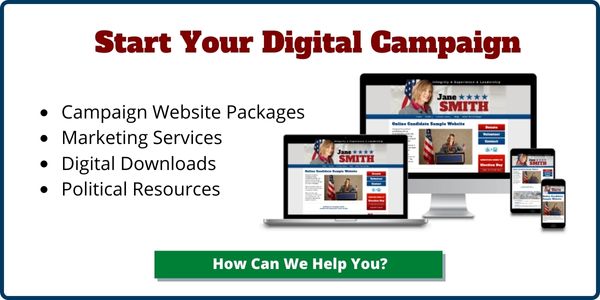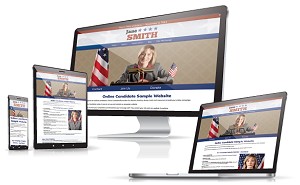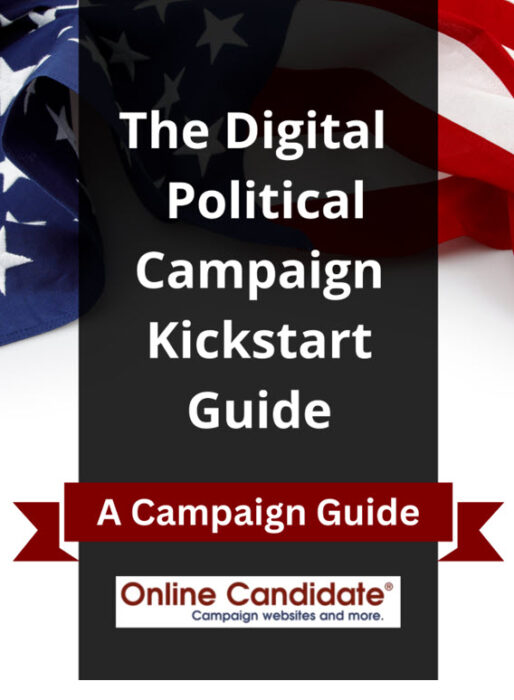Why Starting Your Campaign Website Early Makes Sense
Online political campaigning has evolved over the last decade. While digital strategies have become more sophisticated, the political campaign website has remained the hub of digital campaigns. If you think putting up a website and slapping on a donation button a few weeks before Election Day is a winning tactic, think again.
 Digital campaigning and electronic communication will enhance your credibility when used properly. There is a learning curve, so starting your outreach early will help you learn the tools and get your overall plan in order.
Digital campaigning and electronic communication will enhance your credibility when used properly. There is a learning curve, so starting your outreach early will help you learn the tools and get your overall plan in order.
Here are some other reasons why you should build your political website sooner than later.
Start early to raise money and donations faster
Those who begin their election campaign early have an advantage in raising campaign seed money. Having a website set up for donations makes it easier for donors to contribute. It’s easier to get someone to click and donate than to write out a check, put it in an envelope, and mail it out. You can raise more money faster if you have a way to fundraise online.
Our Lite Campaign Website Package is designed for short-term campaigns or for campaigns that are on a limited budget and just starting out. A lot of our clients use the site to raise initial funds and then upgrade their site for a custom design and additional features in time for the primary or general election.
Search engines need time to find your site
Go ahead, do a search for your name on Google. What shows up? Is it a new article, a LinkedIn profile, a Facebook page, or information about someone else who shares your name? If so, how long do you think it will take for your campaign website to gain traction and rank above the other content?
It might take several weeks or more than a month.
It is unrealistic to simply launch a website a few weeks before an election and hope that voters will find it when they search the internet. Google, in particular, will not just ‘rank’ new, unknown websites—even if the domain contains the candidate’s name. To get a site to show up on Google, it takes both time and the existence of links from other sites pointing to the website.
Because it takes time for candidates to establish themselves online, we include website packages with 6- and 12-month hosting periods. It’s our way of encouraging candidates to start early with their online presence. Waiting a month or two before an election to start campaigning online does not provide enough time to build a network of support.
Note that some elected positions, such as judges or sheriffs, have very specific requirements as to when and how they can raise money or even begin campaigning. As always, check your local election rules before you begin any political activity.
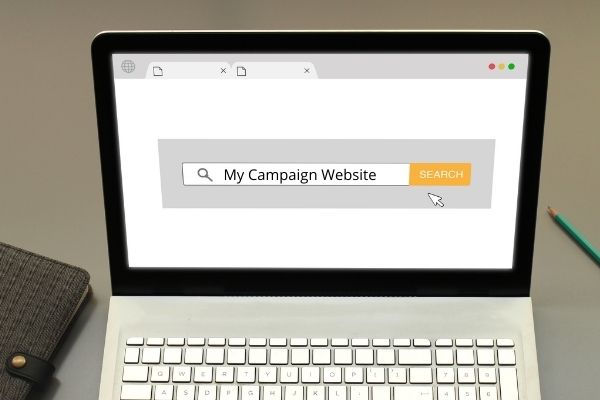
Starting on your own site or someone else’s?
If you’ve done research on political website providers, you’ll find a number of generic website providers offering ‘instant sign-ups’ to get started immediately. Basically, this means that you sign up for monthly (recurring) billing and set up your site from scratch. That includes all pages, forms, and common features. That can take a lot of time.
But wait. Is the site that has just given you an ‘instant’ setup letting you create your own, distinct website? Or is your site just a subfolder or subdomain of another site? Is there a domain name actually included? Does that domain name point to a real, separate domain, or does it just point to a subdomain? (johnsmithcanddiate.websiteservice.com)
Does the website selling the service tell you that information before you sign up? Perhaps more importantly, can you even reach them to answer your questions? How can you contact them? Is there a phone number? Who will answer your question? Where are they located? What if there is a problem?
Online Candidate political campaign websites include a full content management system, built-in pages, forms, and tools to make building and maintaining your campaign website as easy as possible. You can design and build it yourself, or have us do it with flexible, affordable options.
We believe in educating our clients, up-front pricing, and support for our products. We look forward to helping create your online presence!
Online Candidate offers multiple website packages to help you launch fast and look professional. Find out which one fits your campaign.
Related:
How Many Votes Do You Need To Win?
How many votes do you need to win a local election? In its most simple form, the winning formula is:
Expected Vote x .50 + 1 vote = Minimum Votes to Win (50%)
Expected Vote x .52 = Comfortable Margin of Victory (52%)
That’s the quick and dirty calculation for a majority win. Pulling together real-world numbers gets a little trickier. To calculate more accurately how many potential voters you need to win, you’ll need some hard numbers and some educated guesses.
Find the total population of your district:
The total population includes all the people who live in your district, regardless of whether they can vote or not. The population includes those who are not eligible to vote because they are not citizens or, for whatever reason, cannot register.
Determine the total number of voters:
This comprises all the voters in the district who are eligible to vote and can possibly vote in the election.
What is the expected voter turnout?
This is the expected number of votes cast in this election. Not every voter is going to vote. In this case, let history be your guide. If 40% of eligible voters voted in the last local election, and all things being similar, you can figure that roughly 40% will vote again. It the election falls on a national election date in November, check what the turnout was during that year and use it for your baseline percentage.
Check out our free podcast series.
Calculate the number of votes needed:
If you need a majority of the votes to win, the formula above is what your need (50% of turnout plus one vote). In some cases you may only need a plurality of the votes cast or more votes than any other candidate in the race. In a multi-candidate race, you could win with a distinct minority of the vote.
This percentage must be converted into a number of actual votes that will guarantee your victory.
FOR EXAMPLE:
How many votes does a candidate need to win? Say you have 10,000 people in your district. Of those people, only 6,000 are eligible voters. On the last election, 2400 (or 40%) of eligible voters actually voted. The election did not fall on a national election day, and it was only a two-person race. In this case, you will need a minimum of 1201 votes to squeak through a victory. (50% of turnout plus one vote). This assumes your current election will have a similar voter turnout rate as previous elections.
For more accurate results, take an average of the numbers from the last few elections.
It’s best to err on the side of caution and overestimate the number of votes you need. In this case, we’ll round up and calculate with 52% of the turnout, which gives us a rough target of 1248 votes that will be needed to win. Of course, this number will be subject to the overall voter turnout and how many supporters you can get into the voting booth.
Note: The votes needed to win a US Presidential Election is calculated a bit differently. The US President and Vice President are not elected by a direct vote. Instead, a body of 528 Electors choose the candidate through a process called the Electoral College. To be elected to the office of President or Vice President, the candidate needs more than half – at least 270 votes – to win the election.
- Related: How Many Households Must You Reach to Win A Local Election?
- For more online campaigning tips, sign up for free political tips and updates.
Free ‘Don’t Forget To Vote’ Graphic Templates
Just in time for Election Day, here are two free social media templates that you can customize and share with followers to help get out the vote.
One graphic design template is sized for Facebook, the other for Twitter. Customize them the way you want. Change the colors, text, add your campaign logo – anything you want. When you are finished, download them and post them to your social media accounts and your campaign website.
How to use these templates
Create an account with Canva. The free version is enough for most users. However, there are feature advantages with a Pro account.
Click on the links below to open the templates. You will be brought to a page for each template that looks something like this:
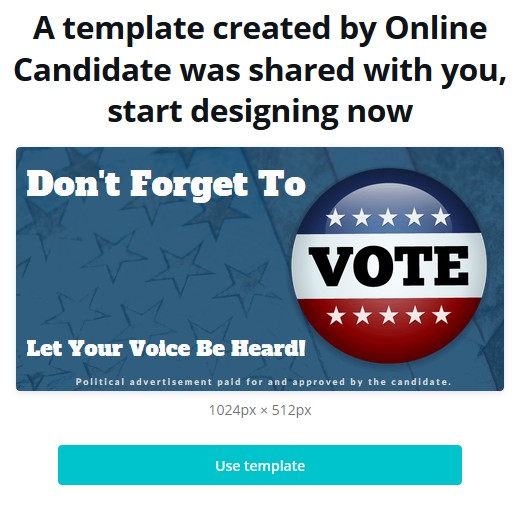
The page displays a template preview along with a button that says “Use Template“. Simply click that button to start editing the template. You can also make a copy so that you can keep an “original” template your Canva account.
From there, you can edit any or all elements and make it your own. You can download your image as a jpg, png or PDF or share your image directly to your social media accounts.
GOTV Facebook Post Template 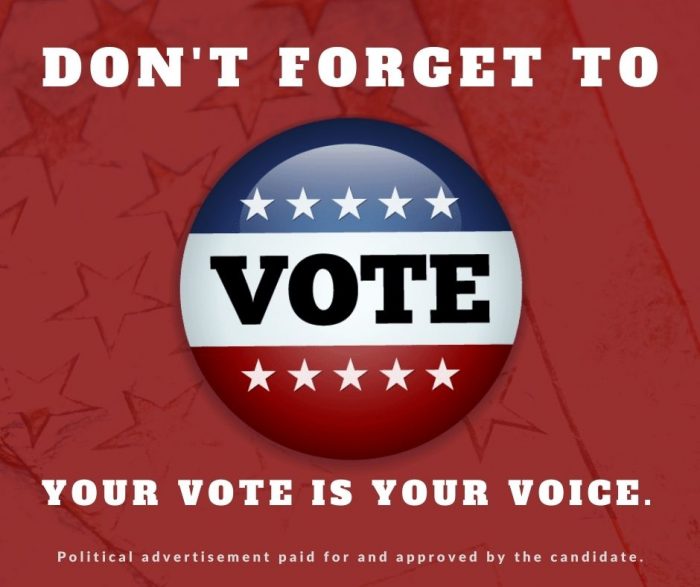 Click to download.
Click to download.
GOTV Twitter Post Template  Click to Download
Click to Download
Online Candidate website clients have access to FREE social media templates, graphic templates, and print templates at OnlineCandidateResources.com. To log in, follow the link from your website administration dashboard.
Like these templates? We also carry Premium Political Canva Print Templates forcandidates, judicial, sheriff and school board candidates.
Reach Voters With Digital GOTV Strategies
As Election Day draws near, it’s time to give a final push to your supporters. An effective Get Out The Vote (GOTV) strategy can make a difference. While your campaign ramps up its direct mail, phone and in-person efforts, don’t forget the online component.
Defining ‘Get Out the Vote’
“Get Out The Vote” or “Get out the vote for me” refers to efforts aimed at increasing voter turnout near election day. Voter participation can be surprisingly low, especially for elections or primaries that occur in the spring or summer.
Traditional GOTV methods include having a candidate and volunteers can go door-to-door and speaking with voters. Another way to get the attention is through display advertising and signage. Phone banking is when your volunteers call large lists of people at the end of the election cycle, encouraging them to vote.

Reconnect with lapsed donors
Those who have already donated to your campaign may be able to donate again. Early donors have already invested in your success. They will likely be interested in seeing things through to the end. At this point, reengaging with previous donors is easier than trying to attract new supporters.
It is worthwhile to set up a plan that encourages donors to give again later on in the campaign. You may want to create incentives for both early and late donors, such as special swag or acknowledgement.
Increase the frequency of email, text messaging and social media updates
Mention latest news, campaign activities, endorsements and media coverage. Increase donation and volunteer requests as it comes down to the line. Remind your online followers about Election Day. Shift your messaging from persuading people to vote for you to reminding them that they should vote for you.
- Voter registration deadlines
- Mail ballot application deadline
- Mail ballot deadline
- Early voting start and end dates
- Times and locations of voting places
Don’t just limit these notifications to email. This information should be shared on your mailers, postcards, social media, phone banking and texting.
[bctt tweet=”Encourage #followers to share information about early #voting, absentee voting, registration deadlines and polling locations. #campaigntips” username=”onlinecandidate”]
Email remains the go-to method for online campaigning
Another successful get out the vote method involves email. If you have built up an email list over the course of the campaign, now is the time to put it into overdrive. Keep reminding subscribers about Election Day, and how important their support mean to you. Make specific volunteer requests for poll monitors and drivers.
Make your final fundraising appeals specific
Let donors know that their money will be used for a specific goal that is critical to victory. For example, you could say that you have one final brochure printed and ready to go, but you need money for the postage – or that you need to hire more phone bank staffers to help get out the vote.

Other ways to mobilize resources for voter turnout
Final reminders across all your communication channels should include the date of the election, links to where the voting locations exist, when they are open, and contact information for those who may need a ride to the polls. Focus your efforts on those areas most likely to support you.
Door to door canvassing
Door-to-door canvassing is an effective way to engage voters. Volunteers can speak with many people in one day and leave literature or small gifts to individuals they speak with. These volunteers can talk to their peers about the importance of voting and encourage them to do so. A Yale Institution for Social and Policy Studies suggests that authentic person-to-person contact helps successfully drive up turnout. Face-to-face contact is one of the most effective tactics candidates can use to mobilize voters.
Many grassroots organizations are doubling down on voter registration drives. These drives often rely on personal communication to get people to sign up and register to vote. A personal touch is what sets these groups apart from the high-cost and impersonal efforts of traditional organizations.
Paid advertising
If you haven’t done so yet, now is the time to ramp up paid advertising. If you are authorized, Facebook ads can expand your reach to followers, friends of followers or individuals based on specific demographic criteria such as by location, age or interests. Consider running display ads on your local newspaper’s website. You can also use pay-per-click advertising on Google to reach people searching for your name or to reach out to a specific audience. IP Targeting allows campaigns to reach eligible voters on a household level.
Personalize your requests when possible
In the final weeks before an election, voters are bombarded with advertising from all sides. In this environment, it’s important to segment and target your messaging. Messaging that resonates with their specific interests will have more of an impact to i.
[bctt tweet=”Make your last #fundraising appeals specific. Let #donors know that their money will be used for a specific goal that is critical to victory. ” username=”onlinecandidate”]
A good GOTV campaign strategy is one that helps increase voter turnout. It is important to remember that the success or failure of a political campaign depends on voter turnout. A candidate’s chances at winning are determined by how many people vote on Election Day or vote ahead of time through mail-in ballots.
A well planned and comprehensive get out the vote strategy can make a huge difference on Election Day. Make sure you do everything possible to motivate your voters before the day comes.
Related:
Besides campaign website services, Online Candidate also provides political marketing services, including social media setup services and political IP Marketing.
Ready or Not, Early Voting Is Almost Here
Does it seem like the election season keeps getting longer and longer?
One reason for this is that early voting has become an ingrained part of the voting process. For many people, voting is a chore. It’s not something they’re excited to do, it’s not something they actively plan for. Early and mail-in voting makes the process more convenient and accessible to those who don’t want to go out on Election Day.
Many candidates focus on the General Election Day in November. But don’t overlook early and absentee voters. Securing early votes helps ensure that your campaign will have a solid foundation going into the final days of the election.
Early voting periods range in length from three to 45 days, depending on your state. Candidates should remind supporters of the important dates and deadlines – and encourage them vote through whatever way they choose. Restrictions often apply, so you need to know your local laws for early voting and for absentee early voting deadlines.

Early Voting Social Media Graphics
For our website clients, we have free Early Voting graphic templates available. Simply copy the Canva template, edit to suit your needs, and download the image for your social media and website.
Brochure and banner templates are also available for clients. They are located under the Campaign Resources section at OnlineCandidateResources.com. (Check your website dashboard for login information.)
If you are looking for a way to reach early voters directly, IP Targeting lets you display banner ads to key voter households.
Right now we have a number of targeting campaigns ready to go next month. We can help you reach voters, too.
How to Run for Local Office: Tips for a Winning Campaign
For most first-time candidates, the process of running a political campaign can be both an exhilarating and bewildering adventure. It’s very normal to be confused about how to get started. But don’t worry, you’re not certainly not alone.
The reality is that launching a successful campaign requires juggling a number of moving parts over a long period of time. They range from developing an engaging message to managing others to navigating campaign financing and disclosure rules. Unless you’re running a very small campaign, you won’t be able to do it all yourself.
In this article, we’ll cover the essentials of how to run for office. We’ll start with what it takes to prepare yourself and figuring out what position you should seek.
Assessing Your Candidacy
Before you jump into full campaign mode, you’ll want take a step back and assess your personal situation. As we guide you through the steps of campaigning, you should start with an understanding your own readiness.
“What is my calling? What am I supposed to do? I think running for office, public office, can be a divine calling. I mean, Ive wrestled with that very question myself.” – Jim Wallis
Are You and Your Family Ready?
Making a run for office is physically and mentally demanding. You will ask a lot of yourself, your family, and even your friends. Ask yourself if you are prepared for going door-to-door, attending multiple events, making phone calls for donations, and meeting with a campaign team that you still have to put together?
If so, great! Now you need to take a look backwards.
In politics, your past can be a potential stumbling block, so it’s crucial to understand address any “skeletons in the closet”. This doesn’t just apply to your own actions but also the prior activities of your family and close friends. Even seemingly minor issues can be blown out of proportion by opponents or the media. A candidate must consider how an embarrassing or painful revelation might might impact their family and career. Because everything becomes fair game during a campaign.
Choosing Your Elected Office and Knowing Why You Want It
Are you eyeing a seat in Congress? Considering a role on the school board? Thinking about joining your local town council? What experience do you can bring to the position? Maybe you manage a business and have strong leadership skills. Perhaps you’ve worked with children and have experience in education. You may have served on a local committee, and now have some political connections.
But beyond experience, how does the position align with your personal goals and values. If you have no interest in education, then perhaps a seat on the school board isn’t for you. But if you have an interest in law enforcement and a background in police training, then maybe you should run for county sheriff.
Next, ask yourself why do you want this job, and what makes you the most qualified person to do it? You’ll be asked this question on the election trail, and you should have an answer ready. Figure out what really drives you to seek public office? Be clear and be able to give your reasons as a short elevator or on the fly ‘stump speech’. This will not only guide your campaign but can provide an easy to understand story to potential voters.
Eligibility Check – Are You Qualified?
Every elected position has specific requirements, so make sure you meet the eligibility criteria before you start campaigning. Most requirements involve residency and/or time of residency and age restrictions. Other qualifications may also be set by your local or state government. These often include specific educational degrees or other types of experience.
Make sure you know these details and you are fully eligible to hold the position. Better to find out early, then before you are in the middle of your candidacy.
Consider your potential opponents. What’s the political landscape in your area? This can effect your chances of even making on the ballot. Will you wind up against an incumbent with a strong track record and deep pockets? Is there a primary that you must win to move forward to the general election? How many people are running? What is your own reputation, and will it hurt or help you? You should realistically gauge your chances of success. If you don’t think you can win one position, perhaps there’s an open seat elsewhere that is more achievable.
Seek Insights
Reach out to others who have previously run for office, preferably someone who has held the same position that you seek. They can offer valuable information and insights. They can give you practical advice on being a candidate. They can also provide insights in working through team dynamics, effective fundraising strategies, identifying potential donors, and other useful tactics. Learning from other’s experiences can save you time and help prevent unnecessary missteps on the trail.
Tip: Start figuring out the position you want to run for long before you need to declare and file any paperwork. Don’t wait until the last minute to throw your hat in the ring.
Assessing Community Needs and Building Support
Now that you’ve looked into the viability of your candidacy, it’s time to position yourself to the electorate. Here’s how you can do it effectively:
Perform a Community Needs Assessment
Look into local issues such as safety and economic well-being. There are often basic voter concerns such as housing, transportation, and healthcare. These are usually the core concerns of any community. But go beyond the superficial issues and learn about the specific issues or circumstances that provide problems to your voters. Perhaps it’s an infrastructure issue on a highway or budgeting issue with the school district.
Dive into demographics of your area. Understand the composition of your district – who lives there, their age groups, economic status, and their backgrounds. Knowing your community’s unique makeup is crucial for developing an authentic campaign message.
Finally, examine history of your local voter participation levels. Analyze past elections to see when and why people turned out to vote. Who comes out during primaries? What about off-year elections? Early voting is more important these days, as well. Review turnout data from previous primaries and elections. This will help you figure out exactly who to reach out to and encourage to vote.
“The art of leadership is saying no, not yes – it’s very easy to say yes.” – Tony Blair
Research and Outreach
Connect with voters based on your community’s unique needs and voter turnout patterns. Whether it’s through town hall meetings, local events, or even social media, start actively engaging with your constituents.
As you move forward, adjust your strategy to appeal to voters and supporters. Address the issues that matter most to them. Begin using their language and concerns to frame your message, positions, and proposed solutions.
Prepare for Your Campaign
Now that you know what position you want, that you meet the requirements for it, and you’ve done your issue research, you’re on the right path. Now, let’s examine the steps for becoming a fully prepared candidate:
Understanding the Requirements
Start by researching the election requirements and deadlines specific to your location. Election rules vary greatly depending on where you’re running. Again, check your state, county, and local regulations to make sure that you meet all the election criteria. Consider bringing on legal assistance for help.
Take Advantage of Candidate Training
Equip yourself with the right knowledge and skills by attending in-person or online candidate training programs. There are a variety of programs offered by organizations like Emerge Virginia, Emily’s List, American Majority, The Blue Institute, and various schools. They offer candidates access to helpful tools, training, and even mentoring.
Build a Strong Campaign Team
Now, let’s talk about building your campaign team. This is a pivotal step for your campaign’s success. Here are the key positions to fill:
- Campaign Manager: This a critical role, as the person responsible for overseeing all campaign operations. This should not be the candidate.
- Treasurer: Manages your campaign budget and funding.
- Communications Director: Responsible for messaging and media.
- Volunteer Coordinator: The head of your campaign’s volunteer force, organizing their efforts.
- Volunteers and Paid Staff: Round out your team with volunteers and paid staff. When people offer to help, give them meaningful tasks like distributing literature, making phone calls, putting up signs, and knocking on doors.
Put together a good political campaign team whose members collectively hold a wide range of skills. Set clear assignments and duties so that everyone knows what to do and what is expected of them. Encourage open and honest communication between members. This will help your campaign run better and reduce individual and team friction.
Crafting an Effective Message
Once the basic building blocks of your campaign are in place, let’s get into creating an effective campaign message that will connect with voters and leave a positive impression:
Identifying Key Issues
First, you need to know the key issues that matter most to your potential supporters. If you are running on issues that don’t matter much to voters, they will tune you out for others who speak to their needs. For example, there was a local village board candidate whose main focus was ‘cleaning up the village’. But all her campaign material dealt with was dog owners who did not clean up after their animals. It might have been important to a few people, but that narrow issue didn’t carry the candidate to victory.
Here are some examples of local issues you might face:
- Traffic congestion.
- Education and school funding.
- Public safety and community policing.
- Affordable housing and urban development.
- Infrastructure needs.
- Senior services
- Economic development and jobs
- Environmental conservation and sustainability.
Once you’ve identified key issues, position your platform to effectively address them. Learn the issues and memorize your positions. Practice your talking points and be prepared to discuss them.
“My experience has proved that a man who is running for office, and is not willing to make his honest opinions known to the public, either has no honest opinions or is not honest about them.” – William Randolph Hearst
Use Consistent Branding
Create a consistent brand for your campaign. This includes:
- Logo Design: Design a memorable campaign logo and come up with a relevant slogan.
- Colors and Fonts: Select a palette of colors and fonts. You may want to keep with standard Republican and Democratic reds and blues, or you may want to have your own colors.
- Style Guide: Develop a style guide for all your written materials. Everything should be consistent, from speeches and press releases to social media posts and campaign literature.
Keep your messaging consistent across all channels, using the same voice and tone, and ensure all communications follow your brand guidelines. If it’s your website, social media profiles, or printed materials, anyone should know it’s you just from glancing at it. A standard look across different mediums helps create a unified and professional image.
Create an Online Presence
Leverage the power of digital tools and social media platforms.
- Create a Campaign Website: Establish an online presence by creating a website for your campaign. This is often the first place voters will go to learn about you and your positions. Most political campaigns raise their first dollar online. Having a website early in the process makes sense.
- Engage on Social Media: Actively engage with your audience on social media platforms like Facebook, X/Twitter, and Instagram. These platforms are your way to connect with voters – but be prepared to pay for that privilege.
- Email List: The one thing you can own online is your email list. Build it, grow it, and protect it. It is far more cost-effective than paying for online advertising.
- Produce Engaging Content: Your print and online material should showcase your campaign’s key issues and positions. Share your vision and your plans to address local concerns.
Navigating the Election Process
Now that you’re ready to dive into the election process, here’s what you need to know and do:
File Your Paperwork – and on Time!
Begin by completing the required paperwork. These typically include a declaration of candidacy, a statement of economic interests, and a nominating petition. These forms can be found on your state’s secretary of state website or your county website.
Once you’ve filled out the necessary paperwork, submit it to the relevant authorities. This will usually be your Secretary of State or your county board of elections office for local elections.
Don’t forget to double-check that everything you submit is properly processed and accepted. If you misfile a form or petition, it can become a disaster.
Declaring Your Candidacy
Now you’ve hit that big milestone! Make your candidacy official by announcing it clearly. Publish a press release that’s compelling and will be attractive to local news sources. Attend local events, connect with community leaders, and engage with voters in person to make yourself visible.
Engage with Voters and Constituents
You can’t win an election if you never interact with anyone. You need to get out there!
Targeting Likely Supporters
Identify Potential Supporters: Review voter registration data to identify potential Democratic or Republican supporters. Seek advice and guidance from your political party and use your knowledge of the community to pinpoint your target audiences. Always tailor your messages to different voter groups based on their specific concerns and interests. Personalized communication goes a long way in making voters feel heard.
Utilizing Door-to-Door Canvassing
Before heading out on your door-to-door canvassing efforts, take the time to establish specific goals. Define your goals each canvassing session. Is it gathering support, identifying potential voters, or distributing campaign materials? Sometimes it might be a combination of the three.
- Focus your canvassing efforts on quality prospects—individuals who are more likely to align with your campaign’s message. Utilize voter registration data, demographic information, and previous engagement history to identify potential supporters.
- Use professional and persuasive scripts that succinctly communicates your campaign’s key points. Homeowners and residents often ask questions to canvassers. Make sure your volunteers are familiar with the candidate’s stances on the important issues.
- Leverage data to inform your canvassing decisions. Analyze voter data to pinpoint areas with the most voter engagement. Prioritize those for canvassing.
Your canvassing message should be clear, concise, and emotionally resonant. Craft your pitch to demonstrate your dedication to addressing the concerns of the community. Leave potential voters with a memorable and compelling message.
Hosting and Attending Community Events
When it comes to fundraising, different meetings serve specific purposes. One-on-one meetings are best suited for approaching major donors, recruiting fundraisers, and inviting prospects to join the finance committee. For more specialized groups, such as individuals who can pool their resources, consider organizing small gatherings. These settings create an excellent opportunity to discuss campaign funding and leverage peer pressure to secure commitments. House parties and small coffee events tend to raise smaller amounts of money, but they are efficient and don’t take up too much candidate time.
Use these events to meet voters, and discuss the problems that are most important to them. Building connections can help secure support for your campaign through donations, volunteers, or even sign placement signups.
Campaign Fundraising and Budgeting
Raising money and staying within a realistic budget are two tough challenges for any political campaign. This means you’re going to have to ask others for money. Most people are not comfortable doing this.
Setting a Fundraising Goal
- Determine Your Revenue Needs: First, consider how much money your campaign requires. Budget for all your expenses, including advertising, staff salaries, travel, and more.
- Assess Donors’ Capacity: Understand the financial capacity of your potential donors. How much can they contribute? Consider various donor segments, from individuals to organizations.
- Ambitious yet Achievable: When setting a fundraising goal, consider the actual revenue required, the capacity of donors and funders to give, and ensure that your goal is ambitious yet achievable.
Your treasurer or financial manager should be on top of your donation efforts from the start.
Planning Your Budget
Create a comprehensive budget that estimates both your campaign’s income and expenses. Consider every cost, from campaign materials to event costs to staff and consultant salaries.
Include a timeline for when each expense should be paid in your budget template and utilize a spreadsheet or budgeting software to monitor and adjust your budget as needed.
Complying with Finance Laws
Familiarize yourself with your state’s campaign finance laws. These regulations dictate much money political candidates can receive from individuals, corporations, and other organizations like PACs.
Different states have different reporting requirements. Ensure you understand when and how to report contributions and expenditures.
For instance, in California, the maximum individual contribution limit to a Small Contributor Committee is $200. In Georgia, individual donors can give up to $8,400 per primary or general election to candidates for statewide office.
You can manage your campaign’s finances and maximize resources by creating a realistic fundraising goals, budgeting properly, and following finance regulations.
Preparing for Election Day
As Election Day draws near, things heat up. Everything you do becomes even more critical. In a close race, every vote counts.
Get Out The Vote Strategies
Start by developing a targeted voter outreach strategy. Identify your supporters and those who are still undecided. Tailor your messages accordingly.
Get your campaign volunteers involved in crucial activities like canvassing and phone banking. Reach out to potential supporters. Remind them that their vote is critically needed, and answer any questions they may have.
Canvassing and Phone Banking
Before you begin canvassing and phone banking, set clear goals for your efforts. How many voters do you want to reach? What message will you convey?
Your volunteers must be trained and prepared. Set specific goals, identify quality prospects, provide your people with a professional script, prepare them with facts and figures. Then put them to work.
Encourage Early Voting and Provide Information
A large amount of early voting can impact the turnout. Encourage supporters to vote early if they can. On your website, social media, and in your literature, share information on how and where they can cast their ballots ahead of Election Day.
Also, provide supporters with accurate information on polling locations. Include addresses, hours of operation, and any special requirements.
Final Notes
Get ready for a challenging experience. Though it may seem far off now, you’ll find that there’s never enough time just before Election Day. There will always be one more thing you could have done, one more donor you could have called, or one more mailer you could have sent…
Best of luck in your campaign!









